|
International and
National |
Susan Davis
to head Personnel Subcommittee
of the House Armed Services Committee
WASHINGTON (Press Release) – Congresswoman Susan Davis (Democrat, California)
was chosen on Thursday, June 14, to serve as Chair of the Personnel Subcommittee
of the House Armed Services Committee. She will be the first San Diegan to
chair the subcommittee.
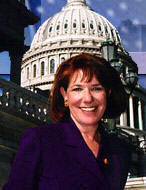 Davis
will replace Rep. Vic Snyder (D-AR) who was chosen to fill the vacancy on the
Oversight and Investigations Subcommittee left by Rep. Marty Meehan (D-MA). Mr.
Meehan is leaving Congress to head the University of Massachusetts. Davis
will replace Rep. Vic Snyder (D-AR) who was chosen to fill the vacancy on the
Oversight and Investigations Subcommittee left by Rep. Marty Meehan (D-MA). Mr.
Meehan is leaving Congress to head the University of Massachusetts.
“I am
honored to be selected by my colleagues for this important position,” said
Davis. “I look forward to addressing the critical needs of our servicemembers
and
Susan Davis
their
families. As someone who represents many military families, I have made their
quality of life issues one of my top priorities.”
“I am
pleased to announce that the House Armed Services Committee Democrats have
elected two very able and dedicated members to lead subcommittees,”said Rep. Ike
Skelton (D-MO), Chairman of the House Armed Services Committee. “Both
Congressman Snyder and Congresswoman Davis bring a great deal of experience and
expertise to their new roles and I am confident they will make us proud as we
work to support our men and women in uniform.”
A leading
advocate for military families in San Diego and around the world, Davis intends
to conduct thoughtful hearings which will focus on the needs of our servicemen
and women and their families.
Mental
health care, especially PTSD, strategic language training, and improving overall
access to care for service members and families are some of the issues the new
chairwoman-select will tackle in the near future.
The
subcommittee’s jurisdiction includes military health care, recruitment and
retention, and military education.
The
selections become official on July 1, 2007.
Davis has
been a member of the Armed Services Committee since 2001. She also serves on the
Oversight and Investigations Subcommittee.
The
foregoing article was provided by the office of Congresswoman Susan Davis
___________________
Ben Gurion
University professor Alon Friedman
honored by Germans for his epilepsy research
BEER SHEVA, Israel—Dr. Alon Friedman has won the prestigious 2007 Michael prize
for epilepsy research from the Michael Foundation of Germany. The Michael Prize
is awarded biennially, and is specially designed to attract scientists under the
age of 45.
He first began exploring the field after a clinical observation that the only
thing patients suffering from epilepsy after a trauma or an illness had in
common was a breakdown in the brain-blood barrier. Over the next 10 years, he
and fellow researchers at the Faculty of Health Sciences at BGU, together with
Professor Uwe Heinemann from the Charite Medical University in Berlin and
Professor Daniela Kaufer from Berkeley University, worked on this question and
today they believe they have found not just the answer, but also a potential
cure that they might one day be able to take back to patient bedsides.
Traditionally it was thought that the way to treat brain diseases was through
the nerve cells. Now doctors take a more holistic approach and look at the
nerves and supporting cells of the brain as a complete functional unit. This
approach is supported by the US medical research organization, the National
Institute of Health. "Most brain diseases originate in blood vessels," explains
Friedman.
Friedman focused on the delicate blood-brain barrier, a barricade in the brain
that separates the bloodstream from the neural connections of the brain. Through
his work with patients, Friedman discovered that many patients who are at risk
of developing epilepsy suffer leaks and tears in the blood-brain barrier. These
leaks can be the result of a head trauma, a stroke, diabetes, or even in some
cases epilepsy itself. Friedman, who carries out his research at the Soroka
University Medical Center and is today one of the leading figures in this field,
found that when the blood-brain barrier was disrupted, albumin, the most common
protein in the bloodstream, leaks through these tears in the barrier into the
brain.
(Jump to continuation)
--------------------------------------------------------------------------------------------
|
Buena Vista Hadassah
cordially invites you to hear
Rabbi Chaplain Joel D. Newman
based on his experiences in the war zone
"Passover in Iraq"
12:30 p.m., Tuesday, June 19
Vista Library, 700 Eucalyptus Avenue, Vista
Free refreshments
For further information: call Vivian (760) 967-0149
|
Ecuador's Minister of Education has both a family and professional interest in
Technion
HAIFA, Israel (Press Release)—Ecuador's Minister of Education, Raul Vallejo,
visited the Technion on June 11. He toured the various faculties and visited
laboratories. He had an excellent guide – his son, Sebastian Vera, who is a
fully accredited student in the Faculty of Mechanical Engineering.
“Before I was appointed Minister of Education, I was the principal of the Albert
Einstein Jewish School in Quito, the capital,” Minister Vallejo explains. “We
have 600 students in our school but only 15% of them are Jewish.
The Jewish community in Ecuador is very small, numbering only 250 families. Most
of the teachers,myself included, are not Jewish but this is how I became
acquainted with Judaism and Israel.”
The Ecuadorian Minister visited Israel twice in the past. When his son was 17
years old, he became interested in robotics. His father suggested that he study
at the Technion in Haifa. Sebastian Vera studied Hebrew in an ulpan at Kibbutz
Baramand then went to the preparatory program at the Technion. He finished
successfully and was accepted to the Faculty of Mechanical Engineering. Now, he
is completing his first semester.
When Sebastian’s mother, Elina Karbo, heard his stories about the Second
Lebanon War, which caught him in the student dorms, she was shocked but says: “I
feel very safe in Israel, more than in my country, where I am surrounded by
bodyguards.”
Minister Vallejo met with Israeli Minister of Education, Prof.Yuli Tamir on
Thursday, June 14, to present to her a multi-year plan for improving the
educational system in his country, which was recently approved by referendum in
Ecuador. “In education, you have to think and plan for the long-range,” he says.
The preceding story was
provided by the Technion.
Brandeis University receives
$15
million from
Schusterman Foundation for Israel studies center
WALTHAM, Mass. (Press Release)—In an effort to expand the field of Israel
Studies on U.S. campuses, the Charles and Lynn Schusterman Family Foundation has
made a commitment to give $15 million to Brandeis University to establish a
center that will stimulate outstanding scholarship and teaching on Israel’s
history, language, culture, and society.
The new Schusterman Center for Israel Studies was conceived jointly by Lynn
Schusterman and Brandeis University President Jehuda Reinharz, Ph.D. ’72, to
meet the critical need for qualified academics to teach about Israel. In
addition to educating graduate-level students at Brandeis, the Center will offer
training, resources and scholarship opportunities for faculty at other
universities.
The gift, the largest single commitment ever made by the 20-year-old foundation,
will be matched by other donors recruited by the University in coming years, as
part of a plan to create a $30 million endowment for the Center by 2015.
“We thank Lynn Schusterman and the Schusterman Family Foundation for
accelerating our work in Israel Studies and promoting rigorous scholarship and
excellent teaching,” Reinharz said. “This Center is the perfect marriage of a
University committed to creating and disseminating knowledge and a
philanthropist interested in making that knowledge available to the wider
public.”
The new Center will promote an interdisciplinary approach to the study of
Israel, integrating the study of the nation’s history, economy, education
system, language, culture and arts, sociology, demography, and politics.
Slightly more than half of all U.S. campuses offer no courses on Israel; another
quarter offer only one course, often focused on the Israeli-Palestinian
conflict, according to a 2006 study by the Israel on Campus Coalition.
“Israel is such an important nation, and yet on many U.S. campuses, it is rarely
studied with any seriousness. It’s time we greatly enhance and expand academic
scholarship about Israel and its people,” said Lynn Schusterman, Chair of the
Charles and Lynn Schusterman Family Foundation.
Already, the Foundation, through its Schusterman Visiting Israel Professors
Program, is bringing 20 academics a year from Israel to teach at American
universities; in addition, the Schusterman Israel Scholar Awards provide funding
for graduate students to encourage them to pursue Israel-related scholarship.
The Schusterman Center will fulfill the immediate need for professors
knowledgeable about Israel by permanently funding the pioneering Brandeis Summer
Institute for Israel Studies, which has trained faculty from nearly 60 colleges
and universities worldwide since its founding in 2003. At the same time, the
Center will address the problem in the future by training and educating graduate
students to become the next generation of Israel Studies scholars.
“When we decided to expand our involvement in supporting outstanding scholarship
in the field of Israel Studies, Brandeis was the obvious place for us to turn,”
Schusterman said.
Brandeis has been a longtime center of Israel-related and Middle East Studies by
virtue of its Crown Center for Middle East Studies, endowed professorships in
Israel Studies (the country’s first) and modern Hebrew literature, and faculty
renowned in their fields of teaching related to Israel. Additionally, Ilan Troen,
the Karl, Harry and Helen Stoll Professor of Israel Studies at Brandeis, is the
founder and editor of the widely distributed Israel Studies journal, which is
published three times a year and sponsored by Brandeis University and Ben-Gurion
University.
The preceding article was
provided by Brandeis University
When
the university reunion is in a country left behind
Being the
product of a Zionist youth movement, almost immediately upon graduating from
university in England I emigrated to Israel. The country was very different from
the world in which I had grown up and all my energies were needed in order to
acclimatise to my new life.
As tends
to happen, events swept me along. Marriage, work and family occupied my mind and
time, and most of my occasional visits to England were devoted to relatives and
one or two friends from my schooldays. The one fellow-student with whom I
remained in contact married a foreign diplomat, and our friendship waned as his
star at the UN rose. Having a friend in Israel was evidently not considered
helpful to his career.
But one
year the London School of Economics, my alma mater, organised a fortieth
anniversary reunion for alumni, ending with a grand dinner at the Houses of
Parliament. I was not prepared to miss that, and duly turned up at the event.
There were very few people that I recognised or remembered, I’m sorry to say.
Some
fellow-students have become quite prominent in politics, law or business, but
most of us have had ‘a steady rise to obscurity,’ as someone put it. Our host at
the gala dinner was Frank Dobson, a former Health Minister and a highly
entertaining after-dinner speaker, of whom I have absolutely no recollection.
The few
students that I remembered also remembered me, however, and we have kept in
touch ever since. On my last visit to London four of us met for lunch, one of
them coming down from the north and another traveling in from Sussex. It was
delightful to hear about what they had been doing and to discuss any number of
topics. It felt as if we had never been out of touch. Now I can only regret all
those years.
The foregoing article was reprinted from the
AJR
Journal (Association of Jewish Refugees) in England.

|
 Your specialist in Your specialist in
cruises and tours
Upcoming 2007 San Diego sailings:
Now-December 29: Carnival:
Elation: multiple 4-and 5-day sailings, round trip to Mexico.
Sept 23-Dec 30: Princess Cruises: Dawn Princess: 7-day round trip to
Mexico
Sept. 28: Celebrity Cruises: Summit: 14-day Hawaii
Sept. 29: Holland America: Oosterdam, 7-day Mexico. |
|
Commentary
We welcome your
comments or replies |
The High
Cost of Free Speech
By Dr. Rachel Ehrenfeld
NEW YORK—On June 8, 2007, seven months after hearing arguments in my suit
against Saudi billionaire Khaled bin Mahfouz—Ehrenfeld vs. bin Mahfouz—the
U.S. Second Circuit Court of Appeals established an important legal precedent,
henceforward affecting all American writers and publishers.
This “case is one of the most important First Amendment cases of the past 25
years,” says prominent civil rights attorney and 30-year American Civil
Liberties Union of Massachusetts board member, Harvey Silverglate. Ironically, the potential of
many foreigners suing U.S. reporters and publishers for libel “to do grave
damage to free press” is “not yet readily recognized,” he adds.
The case concerns my countersuit against the Saudi who sued me for libel in the
U.K. because my book Funding Evil includes details of his financial support to
al-Qaeda and Hamas. In November 2004 , bin Mahfouz — a Saudi citizen, not
British —sued me for libel for reporting these and other “inconvenient” facts.
Bin Mahfouz would enjoy no success were he to sue me for libel in U.S. courts.
My facts are based on official documents, and thereby establish that through his
"Muwafaq Foundation," managed by U.S.-designated terrorist Yassin al-Qadi, bin
Mahfouz financed Hamas, al-Qaeda, and other Islamic terror organizations.
Indeed, the alleged terrorist financier is also a defendant in all federal
lawsuits filed by the 9/11 victims.
But British libel laws, based on the Libel Act of 1819, do not encourage free
speech. These draconian statutes include clauses prohibiting “blasphemous
libel.” They also place the burden of proof on the defendant—who need not have
been malicious. Reporters and publishers must prove the accuracy of their
work—and defense witnesses must produce primary evidence. In my case, even if
U.S. officials would testify for me, they’d need to produce classified documents
available only to those with U.S. national security clearance.
Intended to be democratic, Britain’s libel laws are exploited almost exclusively
by wealthy individuals. In Britain’s High Court, bin Mahfouz’ success in a libel
case against me was all but preordained.
After all, bin Mahfouz has a long history of successful “libel tourisim.” He
sought and received default judgments, fines, apologies and retractions from
more than 30 other writers and publishers—including major U.S. newspapers such
as the Wall Street Journal, New York Times and Washington Post,
none of which have reported on this case or the enormous significance of last
week’s Appellate Court decision.
I refused to acknowledge the lawsuit: British libel laws stand American
principle on its head. Thus, British High Court Justice Eady, who granted bin
Mahfouz many other default judgments, awarded another one to the Saudi, in my
case. In September 2005, he ordered me to pay £114, 386.52, in fines and
expenses, which at today’s exchange rate is $225, 913.37 plus interest. He
ordered my books physically destroyed; they were published only in the U.S. —the
23 copies sold in Britain were purchased online or by special order.
Since the 1965 Uniform Foreign Money-Judgment Recognition Act allows the
enforcement of foreign monitory judgments in the U.S., bin Mahfouz intends to
act. One of his agents appeared late one evening at my door, advising me to “You
had better respond. Sheikh bin Mahfouz is a very important person and you ought
to take very good care of yourself.”
I countersued him in N.Y., asking the Federal Court to declare the default
judgment against me and my book obtained by bin Mahfouz in England's High Court
as unenforceable in the U.S., and contrary to the free speech protections
Americans enjoy.
It is especially significant, therefore, that the Second Circuit Court of
Appeals overruled the U.S. District Court for the Southern District of New York
in requesting that the state’s highest court determine whether bin Mahfouz
should personally be subject to New York jurisdiction.
The Second Circuit’s decision went further, ruling that my claim is “ripe,” and
therefore can be brought before a U.S. court. Thus, every American writer and
publisher, finding themselves in a similar situation, can now seek a U.S. court
decision.
When and if the New York Supreme Court decides that there is jurisdiction over
bin Mahfouz, my case would proceed on its merits. This would allow me to take
pre-trial “discovery” of bin Mahfouz’s financial activities to further confirm
the accuracy of my reporting on him in Funding Evil. Stay tuned.
---
Dr.
Rachel Ehrenfeld is director of the New York based American Center for Democracy.
Here is a link to her
website.
_________________________________
World Jewish Congress is a misnamed billionaires club
By Dov Burt
Levy
BOSTON, Mass.—World Jewish Congress should shutter its windows, lock its doors
for the last time, and disband. Go out of business. Give up that grandiose name,
which does not reflect the organization and how it really works.
Actually, I,
and most of us, appreciate and applaud the work of private American
organizations. To start one, you need only print some stationery, build a
website and get to work looking for like-minded people to pursue shared
interests. As Alexis DeToqueville wrote about his visit to America in 1835-40,
private associations are what differentiate, for the better, the old and new
worlds.
But, the
World Jewish Congress offends me. And you may agree, after I tell you why.
First, the
name of the organization, World Jewish Congress, invokes the idea of an
inclusive, world-wide democratic deliberative body, and transparent like many
others, whose decisions bring benefit to its Jewish constituency. Instead, in
this case you get a self-appointing and self-sustaining oligarchy with fast and
loose financial management. No transparency, no democracy.
The WJC's
name makes it sound official, like the place that governments and institutions
should go to when wishing to address world Jewry. Just as those wanting to
communicate with worldwide Catholicism might look for a Vatican address.
The World
Jewish Congress held an election on June 10, to choose a new president and a new
chairman of its executive committee. Ronald Lauder, heir to the Lauder cosmetic
industry billions won the presidency; Matthew Bronfman, heir to his family's
liquor business fortune won the chairmanship.
Not an
election instilling pride because the number of electors, those with the power
to vote, were so small. The executive committee (11-4), then the board of
directors (59-17) both validated the Lauder-Bronfman slate.
Still,
demonstrating the organization's dysfunction, a major dissent arose when 15
names were added to the board of director voting list at the last minute, the
people, after all, with the final vote in this election.
A
democratic, transparent, deliberative vote, it was not.
More
background. The World Jewish Congress was established in 1936 by Nachum Goldman
as part of the effort to publicize the plight of European Jewry and to gain
support for its rescue.
By 1975, the
organization was tired, in financial trouble, and Edgar Bronfman, looking to
make a contribution to, and a mark in, the Jewish community, made a sizeable
financial contribution and assumed the presidency.
Brooklyn
Rabbi Israel Singer was hired and together the two dominated the organization
for over 30 years.
Five years ago, a secret bank account containing well over a million dollars,
opened by Singer, was found in a Swiss bank.
Singer then
allegedly flew to Geneva, closed the WJC office, dismissed its two employees
(including the one who unearthed the bank account) and Singer transferred the
money to a British bank, as the story goes.
Then New
York Attorney General Eliot Spitzer took on the investigation of the case.
Spitzer's
report and agreement with the WJC in January 2006 was such that both sides could
claim victory. Spitzer concluded that WJC finances "lacked any oversight… by the
governing bodies," barred Singer from any role in the organization's finances,
and required his repayment of "inappropriate disbursements."
But because
Spitzer did not find evidence of an indictable offense, WJC president Edgar
Bronfman, in his relief over the outcome, publicly kissed Singer at a meeting,
and said, "I love you."
Fast-forward
to a year later. On an international teleconference, Edgar Bronfman announces
the firing of Singer for financial irregularities. A bad Mafia film couldn't
have been clumsier.
Singer's
firing fueled more dissension and conflict (Singer did have some supporters
around the world). Bronfman then announced his resignation from the presidency
after 35 years on the job. That set the stage for this week's election and his
son's electoral victory.
Are you
offended, as I am, that a high profile, lofty-sounding Jewish organization
should become the plaything of billionaire heirs?
What a deal.
A million-dollar tax-deductible contribution buys the presidency of a major
Jewish organization. This in turn brings access to prime ministers, presidents,
kings, military and business leaders around the world.
My political
consultant friend, Myron, told me that a battle to close the WJC could not be
won. He advised, "Start a new organization. Name it 'The Galaxy Jewish
Congress.' That will drop the World Jewish Congress down a notch."
Something to
worry about, Messrs. Lauder and Bronfman!
The foregoing
column also appears in the current issue of The Jewish Journal-Boston North
 Jews
in the News Jews
in the News
---------------------------------------------------------------------------------------------------------------
Like you, we're pleased when members of our community are
praiseworthy, and are disappointed when they are blameworthy.
Whether
it's good news or bad news, we'll try to keep track of what's being said in
general media about our fellow Jews.
Our news spotters are Dan Brin in Los Angeles, Donald H. Harrison in San Diego,
and you. Wherever you are, if you see a story of interest, please send a
summary and link to us at sdheritage@cox.net.
To
see a source story click on the link within the respective paragraph.
______________________________________________________________________________________________
*San Diego City Attorney
Mike Aguirre says Mayor Jerry Sanders had a personal meeting with Sunroad
Enterprises owner Aaron Feldman before the city government modified a
stop-work order on the controversial building near Montgomery Field to permit it
to be "winterized." The
story by Jeff McDonald is in today's San Diego Union-Tribune.
*U.S. Bankruptcy Court Judge Jay Cristol has ruled that Fred Goldman,
father of the slain Ron Goldman, is entitled to any proceeds that may
be held in the account of Lorraine Brooks Associates of Miami, Florida, from O.J.
Simpson's book If I Did It. The
story is in today's Public Eye section of the San Diego Union-Tribune.
*A Mighty Heart is about the life and death of journalist Daniel
Pearl, who declared "I am a Jew" before his execution by Islamists
in Pakistan.
But much of the buzz was about whether an attorney for Angelina Jolie was
justified or not in trying to restrict journalists' questions to her about the
movie, rather than personal issues. Such a
story is in the Public Eye column of today's San Diego Union-Tribune.
In Karachi, meanwhile, reporter Laura King provided an update of the
investigation into Pearl's murder. That
story is in the Los Angeles Times.
*A high school named for American Federation of Labor founder Samuel
Gompers will graduate its last class on Tuesday, with students in lower
grades transferring to Lincoln High School. The
story by Helen Gao is in today's San Diego Union-Tribune.
*Gidi Grinstein, an analyst with the Reut Institute, an Israeli think tank,
suggests that having a Fatah-led government in the West Bank and a Hamas-led
government in Gaza may result in two separate tracks toward Palestinian
independence, with Israel taking a softer and more cooperative line in the West
Bank. His comments are included in a roundup
story by Joel Greenberg of The Chicago Tribune on the Gaza situation
that appears in today's San Diego Union-Tribune.
*Long ago the area near MacArthur Park in Los Angeles stopped being a Jewish
neighborhood, but Al Langer, today 94, and his son Norm have kept
their deli open, much to the appreciation of Los Angeles redevelopment officials
and politicians. The story by Bob Pool is in today's Los Angeles Times.
|
  News Sleuths: News Sleuths:
Watching the media
gathering and reporting the news of Jewish interest
|
Date: June 15, 2007
Place: United Nations
Briefing officer: Marie Okabe, deputy spokesperson for Secretary General Ban Ki-moon
Source: United Nations
transcript
Subject: Israel, Gaza
Question:
On the Quartet meeting that’s coming up, given the situation in Gaza right now,
do you know who will be representing the Palestinians at that meeting and is
that going to change? Is there any concern about that meeting being disrupted?
Deputy Spokesperson:
I actually have no further details on a Quartet meeting. But what I told you
today is that the Secretary-General does remain in close consultations with the
parties, both regional and with the Quartet partners, on the way ahead. He did
have a teleconference this morning with the principals and, on an urgent basis,
he will stay in close consultation with them. So I think at the moment, given
the circumstances on the ground, he will be in very close touch with the
principals, and I believe he is expected to have another round to speak to them
as early as next week.
Question:
Does that include President Abbas? Is he in direct contact with him?
Deputy Spokesperson:
This morning’s meeting was with the Quartet principals only, so that’s all I
can confirm for you at the moment.
Question:
And just a quick follow-up. I know the Secretary-General is supposed to meet
with the Israeli Prime Minister this weekend. Given that there was just this
very strong criticism about the UN and its close alliance with the United States
and Israel, is there any concern about the perception of him meeting with the
Israeli Prime Minister this weekend? Will he have any meetings with anybody from
the Palestinian side?
Deputy Spokesperson:
The Secretary-General is in touch with all parties, as I mentioned. He is in
phone contact with all parties. He has travelled to the region. He’s seen
various regional leaders. This is…as we mentioned to you, he is accepting an
invitation to meet with Mr. Olmert on Sunday, and the details of that you will
get from the Israeli mission since they are the ones organizing it.
>>
I have one more item to add to the Middle
East. There’s been a little confusion in some press reports, so I’d just like
to make it clear that when the Secretary-General had an initial exchange of
views with the members of the Security Council at their monthly luncheon on
Tuesday about the possibility of an international presence in Gaza, he was not
presenting his own idea, as some have misinterpreted it in the press. The
Secretary-General had earlier spoken by phone with Palestinian President
Abbas, who had raised with the Secretary-General the
idea of an international presence. So, when he met with Council members for the
luncheon on Tuesday, the Secretary-General conveyed Mr.
Abbas’ views and not his own.
Key: > indicates questions and answers on other subjects intervened
_________________________________________________
The Jewish Grapevine
 -------------------------------------------------------------------------------------------------------------
-------------------------------------------------------------------------------------------------------------
 A
SPECIAL CORNER—This juxtaposition of the American flag and the name "Zion" at
that avenue's intersection with Mission Gorge Road is one of editor Don
Harrison's favorite places to drive past in San Diego. Not only does it
symbolize the junction of two great ideals—America and Zionism—but, by chance,
it also is within view of the Kaiser Hospital where both grandsons of Nancy &
Don were born: Shor and Sky Masori. As the hospital is located on
Zion Avenue, Harrison says his grandchildren were born Zionists. A
SPECIAL CORNER—This juxtaposition of the American flag and the name "Zion" at
that avenue's intersection with Mission Gorge Road is one of editor Don
Harrison's favorite places to drive past in San Diego. Not only does it
symbolize the junction of two great ideals—America and Zionism—but, by chance,
it also is within view of the Kaiser Hospital where both grandsons of Nancy &
Don were born: Shor and Sky Masori. As the hospital is located on
Zion Avenue, Harrison says his grandchildren were born Zionists.
CYBER-REFERRALS—The left is the left,
and the right is the right, except when the twain shall meet bashing Israel.
Bruce Kesler refers us to a
story by Jonathan S.
Tobin in the
Jewish Exponent of Philadelphia.

Look out, Israel! Here come SSDHDS 8th-graders!
Editor's Note: To celebrate their graduation from Soille San Diego Hebrew Day
School, 8th graders took a class trip to Israel, which is still in progress.
Each day the students, and chaperones, post their impressions on a private
website, to which San Diego Jewish World has been granted access. Below are
postings from that site, with original spellings and punctuation. You can
just feel the excitement!
Monday-Tuesday, June
11-12
 Hey,
finally after 18 hours of being on the plane we finally got to Israel. After
being delayed like two and half hours in JFK(it was so awful). I have never seen
a place with so many jews it is so cool. Israel is beautiful i love the plane
trip was so worth it. I would travel 18 hours anytime just to get to Israel. We
met our tour guide Phillip he is very nice and funny. We are on our way to
Kibbutz Lavi. Iam having a great time bye. —Adam Hey,
finally after 18 hours of being on the plane we finally got to Israel. After
being delayed like two and half hours in JFK(it was so awful). I have never seen
a place with so many jews it is so cool. Israel is beautiful i love the plane
trip was so worth it. I would travel 18 hours anytime just to get to Israel. We
met our tour guide Phillip he is very nice and funny. We are on our way to
Kibbutz Lavi. Iam having a great time bye. —Adam
Wednesday, June 13
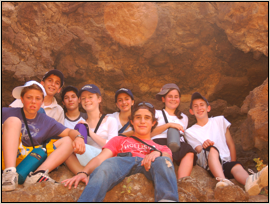 We
all got up at about 6:30, and went to daven, and have breakfast. The first
thing we did, was go and plant pine trees, this was not the most exciting thing,
but i wasn’t hard and was kind of fun. Then we drove for 1/2 an hour to a hike
at Golan Heights. I assumed it wouldn’t be too hard because of our large group.
But i was terribly wrong. We started off going down a large slope, in the heat
and humidity. Then we went up and down, and up and down... Finally we reach
the end where 5 people go swimming, i was not one of them. Everyone was very
hot and tired after the hike. Then we drive somewhere and eat lunch. Finally
we drive to Tzfat and tour around a little bit. We went to a kabalistic art
gallery, who is owned by a friend of the tour guide. We went to the highest
point in Tzfat, and started going down. We davened mincha there and left. Now
were on the bus back to the hotel. Everyone will eat then go to sleep.—Oren We
all got up at about 6:30, and went to daven, and have breakfast. The first
thing we did, was go and plant pine trees, this was not the most exciting thing,
but i wasn’t hard and was kind of fun. Then we drove for 1/2 an hour to a hike
at Golan Heights. I assumed it wouldn’t be too hard because of our large group.
But i was terribly wrong. We started off going down a large slope, in the heat
and humidity. Then we went up and down, and up and down... Finally we reach
the end where 5 people go swimming, i was not one of them. Everyone was very
hot and tired after the hike. Then we drive somewhere and eat lunch. Finally
we drive to Tzfat and tour around a little bit. We went to a kabalistic art
gallery, who is owned by a friend of the tour guide. We went to the highest
point in Tzfat, and started going down. We davened mincha there and left. Now
were on the bus back to the hotel. Everyone will eat then go to sleep.—Oren
Thursday, June 14
 It’s
been an amazing day. The kids and chaperones are totally wiped out but on an
incredible high. As you’ve probably heard in my enthusiasm (and fear that the we
“girls” would over sleep on Thursday morning I sprang out of bed to the thought
that the darn hotel didn’t give me my 6:30 AM wake up call. It wasn’t until I
was showered and someone asked the time (at 5:40) did I realize my mistake! You
can imagine how happy the girls were with me!!! Not too worry, most are speaking
to me again with the promise of an ice cream on me! It’s
been an amazing day. The kids and chaperones are totally wiped out but on an
incredible high. As you’ve probably heard in my enthusiasm (and fear that the we
“girls” would over sleep on Thursday morning I sprang out of bed to the thought
that the darn hotel didn’t give me my 6:30 AM wake up call. It wasn’t until I
was showered and someone asked the time (at 5:40) did I realize my mistake! You
can imagine how happy the girls were with me!!! Not too worry, most are speaking
to me again with the promise of an ice cream on me!
It’s been
fantastic watching the dynamic of the class. They are so close and there is a
wonderful vibe as a group. It’s been really interesting just watching their
bonding as a group and enthusiasm emerge . They all started out sitting in the
back of the bus when we arrived at Ben Gurion airport. As of yesterday some of
the chaperones were displaced to the back of the bus as the group, as a whole
has been moving forward (and actually listening as our tour guide Philip speaks
to them!)
After
visiting Tzipori and then going to Kfat Kedem (where we dressed up in kafias,
made the most delicious pita and rode donkeys -yup, even me!) we went on an
extraordinary hike down the Arbel. According to our guide- it was “all down
hill” although a little challenging. Well... holding on to handrails when there
was a very narrow, sheer part of the cliff to climb down-- yes, that was a bit
“challenging.” Many of our kids found it to be “a walk in the park”, for others
however this really challenged their sense of adventure! I will tell you though-
(with the help of their friends and chaperones - they prevailed, overcame their
fears [which honestly were significant] and came down glowing. Their friends
were SO supportive it was incredible to see. You would all have been proud of
all of them.
After a
stop at Rabbi Akiva and the Ramchal’s kevarim to daven mincha we wrote a note to
the people at Kfar Kedem to say thank you and attached it to a homing pigeon!!!
After ANOTHER fleisig, chicken shnitzel filled dinner (you can tell I’m happy
about that!), while we were on our boat ride in Tiberias we heard from the Kfar
Kedem people that the pigeon had delivered our message. Very cool!
Now we are
on to our Yerushalaim portion of the trip. The kids’ excitement is palpable.
More to come!!!!! --hilda
Friday, June 15
Hey Guys!
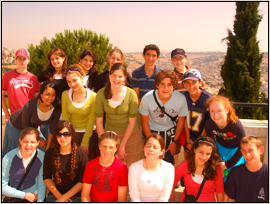 Today
we went to the old city for the first time! The weather was wonderful, and the
Rova was, as usual, filled with jews and non-jews from all walks of life. We
also went through Chizkeyahu’s water tunnels. In the middle Philip made us turn
off our flashlights and walk in the dark! Huddling close together and singing
encouraging songs as we went, we slowly made our way through the blackness. But
there was a light at the end of the tunnel! We came out of the other end and
walked (or should I say shlepped?) our way up an unbeleivably high hill. You
heard that Jesus walked on water? Well I walked up a wall!!! After that we
toured the old city, and split up for lunch. Yes Dad, I did go to Bonkers, I
also bought a lot of candy in case Daniel is reading this. After that we went on
a scavenger hunt, which my team naturally won. Then we went back to the hotel
where I found Avigail waiting for me, cute as ever. Now it’s almost shabbos, and
I have to go. I love you guys so much, and I miss you! Love, —Leah Today
we went to the old city for the first time! The weather was wonderful, and the
Rova was, as usual, filled with jews and non-jews from all walks of life. We
also went through Chizkeyahu’s water tunnels. In the middle Philip made us turn
off our flashlights and walk in the dark! Huddling close together and singing
encouraging songs as we went, we slowly made our way through the blackness. But
there was a light at the end of the tunnel! We came out of the other end and
walked (or should I say shlepped?) our way up an unbeleivably high hill. You
heard that Jesus walked on water? Well I walked up a wall!!! After that we
toured the old city, and split up for lunch. Yes Dad, I did go to Bonkers, I
also bought a lot of candy in case Daniel is reading this. After that we went on
a scavenger hunt, which my team naturally won. Then we went back to the hotel
where I found Avigail waiting for me, cute as ever. Now it’s almost shabbos, and
I have to go. I love you guys so much, and I miss you! Love, —Leah
To be continued...

|
Arts,
Entertainment & Dining |
|
If you have a serious interest in Jewish
culture
and you would enjoy writing reviews, attending premieres,
reporting on special events, then
San
Diego Jewish World
may have just the volunteer position for you.
We're looking for columnists and writers on a wide variety of subjects
who can help us interpret the Jewish experience. Please contact
Don Harrison, editor, at (619) 265-0808 or via this
email
link if you are interested in
joining our creative team
|
Hebrew
University scans, uploads 1,042-page mahzor dating back to 1331 in
Nuremberg
JERUSALEM (Press Release)—The valuable and unique Nuremberg Mahzor of 1331 has
been scanned and uploaded to the Internet site of the Jewish National and
University Library of the Hebrew University of Jerusalem.
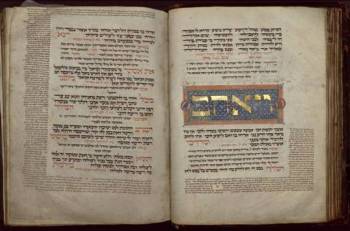 The
Nuremberg Mahzor is a unique treasure from the Middle Ages. The illustrated
manuscript weighs 23 kilograms and encompasses 1,042 pages, each of which is 50
by 37 centimeters in size. The mahzor includes prayers and piyutim (liturgical
poems) for the whole years according to the Ashkenazi tradition, as well as the
five megillot (Biblical scrolls), the haftarot (portions read after the Torah
readings on Sabbaths and holidays) and also a comprehensive collection of
commentaries on the piyutim and prayers which were written in the margins of the
pages. The
Nuremberg Mahzor is a unique treasure from the Middle Ages. The illustrated
manuscript weighs 23 kilograms and encompasses 1,042 pages, each of which is 50
by 37 centimeters in size. The mahzor includes prayers and piyutim (liturgical
poems) for the whole years according to the Ashkenazi tradition, as well as the
five megillot (Biblical scrolls), the haftarot (portions read after the Torah
readings on Sabbaths and holidays) and also a comprehensive collection of
commentaries on the piyutim and prayers which were written in the margins of the
pages.
The manuscript was written in Germany in 1331 by a scribe, clearly identified as
Matanya, for Yehoshua ben Yitzhak. The commentaries in the margins, however,
were written by another scribe, whose name was apparently Yaakov. The
manuscript’s nickname derives from the fact that since the expulsion of the Jews
from Nuremberg in 1499, it was held in the Nuremberg Municipal Library until
1951.
It is the combination and juxtaposition of a number of unusual and sometimes
unique aspects that make this manuscript special. It is one of the largest and
heaviest codices to have survived anywhere. From an artistic point of view, the
ornamentation, painting and decoration in the style of the Upper Rhine valley,
are of a very high standard. The mahzor is also unique for its textual content,
containing many piyutim not found in any other source. Moreover, the many
commentaries have never been researched or published.
The mahzor was purchased by the prominent German-Jewish businessman and
publisher Zalman Schocken towards the end of his life. Today it belongs to Dr.
David and Jemima Jesselson and is kept at the Israel Museum. The uploading of
the mahzor to the Internet was made possible thanks to the Jesselsons. The
Jewish National and University Library hope that other owners of rare works of
Judaica will emulate them and enable the general public to gain access to these
works via the internet.
The Nuremberg Mahzor is the latest treasure to be added to the JNUL online
collection, which, through the David and Fela Shapell Digitization Project, has
already made available to the world public such items as original manuscripts,
decorative marriage contracts and ethnic musical selections.
The Nuremberg Mahzor can be accessed by following the link to
this website.
The preceding story was provided by Hebrew
University.
Epilepsy research ...
(Continued from above)
When the albumin comes into contact with specific brain cells it interacts
harmfully with them. This leads to a chain of molecular events (changes in the
levels of specific brain proteins) that cause abnormal cell activity. This
abnormal activity often takes the form of an epileptic seizure, and later causes
brain cell degeneration. Epilepsy can occur many years after the trauma, so a
trauma in birth or early childhood might only trigger fits much later in life.
“This signal only normally happens once in the development of the brain, when
the brain is still developing in uteri and in the first few months after birth,"
Friedman says. "We discovered that it happens again after a brain injury. The
brain "feels" something terrible has happened and in some ways goes back into
development mode. It seems as if the brain is trying to cure itself, but for an
adult brain to go back into the same kind of development he experienced as an
embryo is very dangerous. The disadvantages are much greater than the
advantages."
While epilepsy has many causes, including kidney disease and genetic
inheritance, for elderly people stroke is a common cause of epilepsy, while in
younger patients, head trauma is a more likely cause. By identifying the harmful
interactions between serum albumin and brain cells that trigger epilepsy,
Friedman believes that he can block the signal to prevent this disease from
developing. "If we try to block this signal we prevent the changes from
occurring," he says.
So far, Friedman and his researchers have carried out animal tests and have
proven that they can successfully prevent the development of epilepsy in most
animals. Friedman's research in experimental animals has led him and Dr. Ilan
Shelef, the head of the MR Unit in Soroka Medical Center to a series of
observations in human patients confirming the importance of the blood-brain
barrier in causing neurological disorders. In the future Friedman hopes to
follow up these observations with clinical tests. "At this stage we are looking
to carry out more animal and clinical studies. We need to follow patients to see
if our hypothesis is correct, then we have to find the right drugs to make this
possible. It will take a few more years before a clinical treatment is ready,"
he says.
Friedman believes the strength of his research lies in the fact that he works
closely with patients. "This is unique," he explains. "We go from the bedside of
the patient, to the bench in the lab, and back to the bedside again. Most
researchers work at university institutions and don't spend much time with
patients, we are lucky enough to work within Soroka Medical Center itself. "In
the past most medical research was clinical but since privatization and
economization, research has moved out of the hospitals. Today's hospital
directors are under pressure to make a profit, they don't have the money to care
about research because in the short term it's not profitable," he adds.
Friedman first became interested in the working of the blood-brain barrier while
he served his compulsory military service as a field doctor in the Israel
Defense Force. During this time he noticed that severe stress in soldiers can
also lead to leakages in the blood-brain barrier with accompanying problems. He
continues to research this area. "Over the years, thousands of different drugs
have been developed for stroke and trauma patients, but most of them have
failed, because the problem is that people have regarded the mechanisms of these
diseases as the same," explains Friedman.
"We have to get away from the idea that there is one disease and one problem,"
he continues. "Not all stroke or trauma patients are the same. In 30 percent of
these patients there are tears in the blood-brain barrier - our treatment would
be aimed at them specifically. It doesn't matter if the problem occurred because
of trauma, infection, bacteria or stroke, if we have this problem of a tear,
then we may have a way to prevent the brain damage."
|
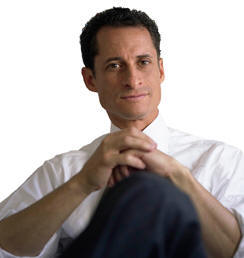 Weiner
first introduced legislation in Congress to cut off funding
for the Palestinian Authority, the West Bank, and Gaza more
than five years ago, citing the misuse of these funds which
embolden terrorism.
Weiner
first introduced legislation in Congress to cut off funding
for the Palestinian Authority, the West Bank, and Gaza more
than five years ago, citing the misuse of these funds which
embolden terrorism.  Davis
will replace Rep. Vic Snyder (D-AR) who was chosen to fill the vacancy on the
Oversight and Investigations Subcommittee left by Rep. Marty Meehan (D-MA). Mr.
Meehan is leaving Congress to head the University of Massachusetts.
Davis
will replace Rep. Vic Snyder (D-AR) who was chosen to fill the vacancy on the
Oversight and Investigations Subcommittee left by Rep. Marty Meehan (D-MA). Mr.
Meehan is leaving Congress to head the University of Massachusetts.
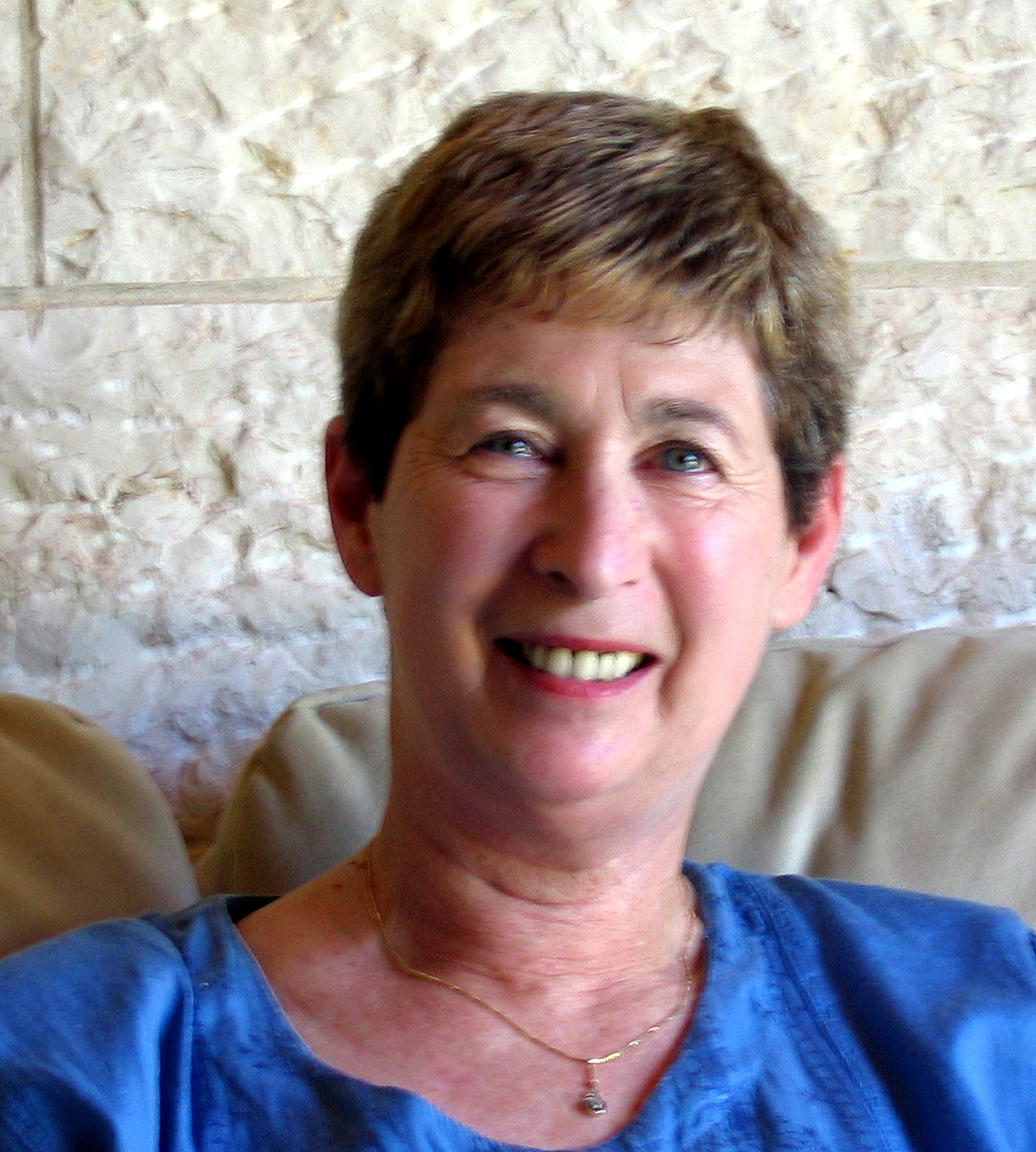

 Your specialist in
Your specialist in
 Jews
in the News
Jews
in the News
 News Sleuths:
News Sleuths: 
 A
SPECIAL CORNER—This juxtaposition of the American flag and the name "Zion" at
that avenue's intersection with Mission Gorge Road is one of editor Don
Harrison's favorite places to drive past in San Diego. Not only does it
symbolize the junction of two great ideals—America and Zionism—but, by chance,
it also is within view of the Kaiser Hospital where both grandsons of Nancy &
Don were born: Shor and Sky Masori. As the hospital is located on
Zion Avenue, Harrison says his grandchildren were born Zionists.
A
SPECIAL CORNER—This juxtaposition of the American flag and the name "Zion" at
that avenue's intersection with Mission Gorge Road is one of editor Don
Harrison's favorite places to drive past in San Diego. Not only does it
symbolize the junction of two great ideals—America and Zionism—but, by chance,
it also is within view of the Kaiser Hospital where both grandsons of Nancy &
Don were born: Shor and Sky Masori. As the hospital is located on
Zion Avenue, Harrison says his grandchildren were born Zionists.
 Hey,
finally after 18 hours of being on the plane we finally got to Israel. After
being delayed like two and half hours in JFK(it was so awful). I have never seen
a place with so many jews it is so cool. Israel is beautiful i love the plane
trip was so worth it. I would travel 18 hours anytime just to get to Israel. We
met our tour guide Phillip he is very nice and funny. We are on our way to
Kibbutz Lavi. Iam having a great time bye. —Adam
Hey,
finally after 18 hours of being on the plane we finally got to Israel. After
being delayed like two and half hours in JFK(it was so awful). I have never seen
a place with so many jews it is so cool. Israel is beautiful i love the plane
trip was so worth it. I would travel 18 hours anytime just to get to Israel. We
met our tour guide Phillip he is very nice and funny. We are on our way to
Kibbutz Lavi. Iam having a great time bye. —Adam We
all got up at about 6:30, and went to daven, and have breakfast. The first
thing we did, was go and plant pine trees, this was not the most exciting thing,
but i wasn’t hard and was kind of fun. Then we drove for 1/2 an hour to a hike
at Golan Heights. I assumed it wouldn’t be too hard because of our large group.
But i was terribly wrong. We started off going down a large slope, in the heat
and humidity. Then we went up and down, and up and down... Finally we reach
the end where 5 people go swimming, i was not one of them. Everyone was very
hot and tired after the hike. Then we drive somewhere and eat lunch. Finally
we drive to Tzfat and tour around a little bit. We went to a kabalistic art
gallery, who is owned by a friend of the tour guide. We went to the highest
point in Tzfat, and started going down. We davened mincha there and left. Now
were on the bus back to the hotel. Everyone will eat then go to sleep.—Oren
We
all got up at about 6:30, and went to daven, and have breakfast. The first
thing we did, was go and plant pine trees, this was not the most exciting thing,
but i wasn’t hard and was kind of fun. Then we drove for 1/2 an hour to a hike
at Golan Heights. I assumed it wouldn’t be too hard because of our large group.
But i was terribly wrong. We started off going down a large slope, in the heat
and humidity. Then we went up and down, and up and down... Finally we reach
the end where 5 people go swimming, i was not one of them. Everyone was very
hot and tired after the hike. Then we drive somewhere and eat lunch. Finally
we drive to Tzfat and tour around a little bit. We went to a kabalistic art
gallery, who is owned by a friend of the tour guide. We went to the highest
point in Tzfat, and started going down. We davened mincha there and left. Now
were on the bus back to the hotel. Everyone will eat then go to sleep.—Oren It’s
been an amazing day. The kids and chaperones are totally wiped out but on an
incredible high. As you’ve probably heard in my enthusiasm (and fear that the we
“girls” would over sleep on Thursday morning I sprang out of bed to the thought
that the darn hotel didn’t give me my 6:30 AM wake up call. It wasn’t until I
was showered and someone asked the time (at 5:40) did I realize my mistake! You
can imagine how happy the girls were with me!!! Not too worry, most are speaking
to me again with the promise of an ice cream on me!
It’s
been an amazing day. The kids and chaperones are totally wiped out but on an
incredible high. As you’ve probably heard in my enthusiasm (and fear that the we
“girls” would over sleep on Thursday morning I sprang out of bed to the thought
that the darn hotel didn’t give me my 6:30 AM wake up call. It wasn’t until I
was showered and someone asked the time (at 5:40) did I realize my mistake! You
can imagine how happy the girls were with me!!! Not too worry, most are speaking
to me again with the promise of an ice cream on me! Today
we went to the old city for the first time! The weather was wonderful, and the
Rova was, as usual, filled with jews and non-jews from all walks of life. We
also went through Chizkeyahu’s water tunnels. In the middle Philip made us turn
off our flashlights and walk in the dark! Huddling close together and singing
encouraging songs as we went, we slowly made our way through the blackness. But
there was a light at the end of the tunnel! We came out of the other end and
walked (or should I say shlepped?) our way up an unbeleivably high hill. You
heard that Jesus walked on water? Well I walked up a wall!!! After that we
toured the old city, and split up for lunch. Yes Dad, I did go to Bonkers, I
also bought a lot of candy in case Daniel is reading this. After that we went on
a scavenger hunt, which my team naturally won. Then we went back to the hotel
where I found Avigail waiting for me, cute as ever. Now it’s almost shabbos, and
I have to go. I love you guys so much, and I miss you! Love, —Leah
Today
we went to the old city for the first time! The weather was wonderful, and the
Rova was, as usual, filled with jews and non-jews from all walks of life. We
also went through Chizkeyahu’s water tunnels. In the middle Philip made us turn
off our flashlights and walk in the dark! Huddling close together and singing
encouraging songs as we went, we slowly made our way through the blackness. But
there was a light at the end of the tunnel! We came out of the other end and
walked (or should I say shlepped?) our way up an unbeleivably high hill. You
heard that Jesus walked on water? Well I walked up a wall!!! After that we
toured the old city, and split up for lunch. Yes Dad, I did go to Bonkers, I
also bought a lot of candy in case Daniel is reading this. After that we went on
a scavenger hunt, which my team naturally won. Then we went back to the hotel
where I found Avigail waiting for me, cute as ever. Now it’s almost shabbos, and
I have to go. I love you guys so much, and I miss you! Love, —Leah
 The
Nuremberg Mahzor is a unique treasure from the Middle Ages. The illustrated
manuscript weighs 23 kilograms and encompasses 1,042 pages, each of which is 50
by 37 centimeters in size. The mahzor includes prayers and piyutim (liturgical
poems) for the whole years according to the Ashkenazi tradition, as well as the
five megillot (Biblical scrolls), the haftarot (portions read after the Torah
readings on Sabbaths and holidays) and also a comprehensive collection of
commentaries on the piyutim and prayers which were written in the margins of the
pages.
The
Nuremberg Mahzor is a unique treasure from the Middle Ages. The illustrated
manuscript weighs 23 kilograms and encompasses 1,042 pages, each of which is 50
by 37 centimeters in size. The mahzor includes prayers and piyutim (liturgical
poems) for the whole years according to the Ashkenazi tradition, as well as the
five megillot (Biblical scrolls), the haftarot (portions read after the Torah
readings on Sabbaths and holidays) and also a comprehensive collection of
commentaries on the piyutim and prayers which were written in the margins of the
pages.